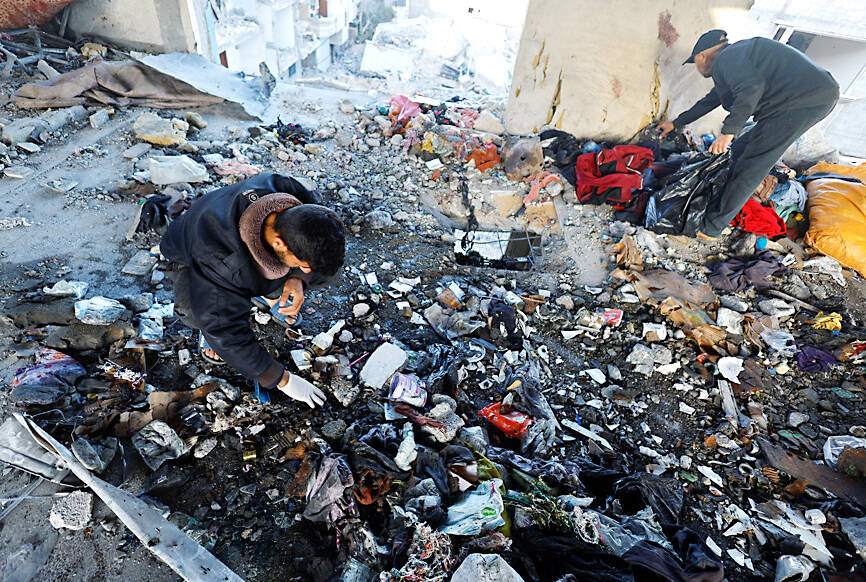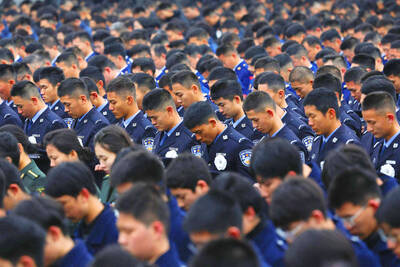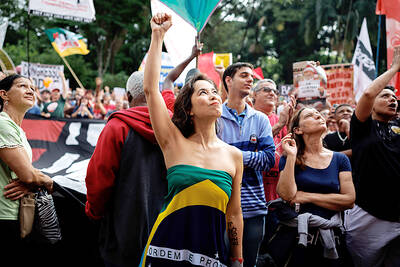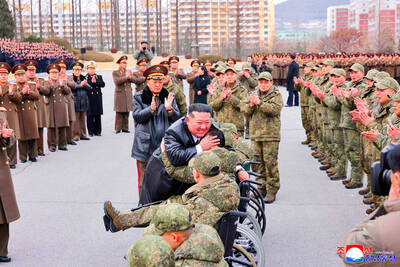Israel on Sunday said that it would close its embassy in Ireland as relations deteriorated over the war in Gaza, where Palestinian medical officials said new Israeli airstrikes killed more than 46 people, including several children.
The decision to close the embassy came in response to what Israeli Minister of Foreign Affairs Gideon Saar described as Ireland’s “extreme anti-Israel policies.”
Israel in May recalled its ambassador to Dublin after Ireland announced, along with Norway, Spain and Slovenia, that it would recognize a Palestinian state.

Photo: Reuters
The Irish Cabinet last week decided to formally intervene in South Africa’s case against Israel at the International Court of Justice, which accuses Israel of committing genocide in Gaza.
Israel denies it.
“We are concerned that a very narrow interpretation of what constitutes genocide leads to a culture of impunity in which the protection of civilians is minimized,” Irish Minister for Foreign Affairs Micheal Martin said.
Saar’s statement on the embassy closure said that “Ireland has crossed every red line in its relations with Israel.”
Irish Prime Minister Simon Harris called the decision to close the embassy “deeply regrettable.”
“I utterly reject the assertion that Ireland is anti-Israel. Ireland is pro-peace, pro-human rights and pro-international law,” he wrote on social media.
Israeli forces on Sunday continued to pound Gaza, including the largely isolated north, as the Palestinian death toll in the war approached 45,000.
A large explosion lit up the southern Gaza skyline on Sunday night.
An Israeli airstrike hit a school and killed at least 16 people in the southern city of Khan Younis, according to Nasser Hospital, where the bodies were taken.
There was no immediate Israeli military statement.
In the north, an airstrike hit Khalil Aweida school in the town of Beit Hanoun and killed at least 15 people, according to nearby Kamal Adwan Hospital where the casualties were taken. The dead included two parents and their daughter, and a father and his son, the hospital said.
In Gaza City, at least 17 people, including six women and five children, were killed in three airstrikes that hit houses sheltering displaced people, according to al-Ahli Baptist Hospital.
“We woke up to the strike. I woke up with the rubble on top of me,” said a bandaged Yahia al-Yazji, who grieved for his wife and daughter. “I found my wife with her head and skull visible, and my daughter’s intestines were gone. My wife was three months pregnant.”
His hand rested on a body wrapped in a blanket on the floor.
Israel’s military in a statement said that it struck a “terrorist cell” in Gaza City and a “terrorist meeting point” in the Beit Hanoun area.
Another Israeli airstrike killed a Palestinian journalist working for al-Jazeera, Ahmed al-Lawh, in central Gaza, a hospital and the Qatari-based TV station said.
The strike hit Gaza’s civil defense agency in the urban Nuseirat refugee camp, al-Awda Hospital said. Also killed were three civil defense workers, including the local head of the agency, according to al-Aqsa Martyrs hospital.
One of the bodies was covered with an orange work jacket marked “ambulance” in English.
“We, the civil defense, are carrying out humanitarian work like in any country in the world. Why are we being targeted?” Kerem al-Dalou said.
Israel’s military said that it struck a militant command center embedded in the civil defense offices.
Most of Gaza’s population of more than 2 million has been displaced, often multiple times. The hospitals that are still functioning say they lack medicines, fuel and other basic supplies, while aid groups warn of widespread hunger.
World Food Program executive director Cindy McCain told CBS on Sunday that the UN agency was able to get just two trucks of supplies into Gaza last month, citing insecurity.
“We need a ceasefire, and we need it now,” she said. “We can no longer sit by and just allow these people to starve to death.”

China yesterday held a low-key memorial ceremony for the 1937 Nanjing Massacre, with Chinese President Xi Jinping (習近平) not attending, despite a diplomatic crisis between Beijing and Tokyo over Taiwan. Beijing has raged at Tokyo since Japanese Prime Minister Sanae Takaichi last month said that a hypothetical Chinese attack on Taiwan could trigger a military response from Japan. China and Japan have long sparred over their painful history. China consistently reminds its people of the 1937 Nanjing Massacre, in which it says Japanese troops killed 300,000 people in what was then its capital. A post-World War II Allied tribunal put the death toll

‘NO AMNESTY’: Tens of thousands of people joined the rally against a bill that would slash the former president’s prison term; President Lula has said he would veto the bill Tens of thousands of Brazilians on Sunday demonstrated against a bill that advanced in Congress this week that would reduce the time former president Jair Bolsonaro spends behind bars following his sentence of more than 27 years for attempting a coup. Protests took place in the capital, Brasilia, and in other major cities across the nation, including Sao Paulo, Florianopolis, Salvador and Recife. On Copacabana’s boardwalk in Rio de Janeiro, crowds composed of left-wing voters chanted “No amnesty” and “Out with Hugo Motta,” a reference to the speaker of the lower house, which approved the bill on Wednesday last week. It is

FALLEN: The nine soldiers who were killed while carrying out combat and engineering tasks in Russia were given the title of Hero of the Democratic People’s Republic of Korea North Korean leader Kim Jong-un attended a welcoming ceremony for an army engineering unit that had returned home after carrying out duties in Russia, North Korean state media KCNA reported on Saturday. In a speech carried by KCNA, Kim praised officers and soldiers of the 528th Regiment of Engineers of the Korean People’s Army (KPA) for “heroic” conduct and “mass heroism” in fulfilling orders issued by the ruling Workers’ Party of Korea during a 120-day overseas deployment. Video footage released by North Korea showed uniformed soldiers disembarking from an aircraft, Kim hugging a soldier seated in a wheelchair, and soldiers and officials

Cozy knits, sparkly bobbles and Santa hats were all the canine rage on Sunday, as hundreds of sausage dogs and their owners converged on central London for an annual parade and get-together. The dachshunds’ gathering in London’s Hyde Park came after a previous “Sausage Walk” planned for Halloween had to be postponed, because it had become so popular organizers needed to apply for an events licence. “It was going to be too much fun so they canceled it,” laughed Nicky Bailey, the owner of three sausage dogs: Una and her two 19-week-old puppies Ember and Finnegan, wearing matching red coats and silver